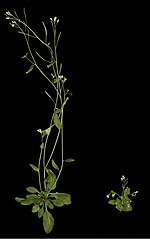Tolerance is the ability of plants to mitigate the negative fitness effects caused by herbivory. It is one of the general plant defense strategies against...
37 KB (5,335 words) - 11:44, 7 December 2023
Plant defense against herbivory or host-plant resistance (HPR) is a range of adaptations evolved by plants which improve their survival and reproduction...
97 KB (11,260 words) - 23:56, 25 March 2024
Plant defense may refer to: Plant defense against herbivory Inducible plant defenses against herbivory Plant tolerance to herbivory Plant use of endophytic...
353 bytes (66 words) - 23:14, 20 October 2023
Immunotherapy Infectious tolerance Mithridatism Plant tolerance to herbivory Medawar P (December 12, 1960). "Nobel Lecture: Immunological Tolerance". The Nobel Prize...
50 KB (6,030 words) - 23:18, 28 May 2024
all aspects of plant growth and development, including embryogenesis, the regulation of organ size, pathogen defense, stress tolerance and reproductive...
56 KB (7,035 words) - 15:39, 17 May 2024
Plants and herbivores have co-evolved together for 350 million years. Plants have evolved many defense mechanisms against insect herbivory. Such defenses...
14 KB (1,985 words) - 03:54, 24 May 2024
Plant cognition Plant defense against herbivory Plant evolutionary developmental biology Plant perception (paranormal) Plant tolerance to herbivory Rapid...
47 KB (5,419 words) - 22:23, 1 January 2024
which kills caterpillars. Many plants give off such herbivory-induced signals. Plants secrete a variety of chemicals to help seal off damaged areas. For...
14 KB (1,480 words) - 18:57, 11 April 2024
plant (and hence a reduction of disease), while the term disease tolerance describes plants that exhibit little disease damage despite substantial pathogen...
64 KB (7,368 words) - 18:07, 29 April 2024
content of the plant and enhance or begin production of secondary metabolites. The change in chemical composition acts to deter herbivory by insects, grazing...
72 KB (8,266 words) - 05:44, 4 April 2024
flowering plants, but it can be beneficial; it can stimulate plant growth, improve tolerance of oxidative stress, and increase resistance to pathogens...
57 KB (7,336 words) - 13:52, 30 May 2024
the dropping stimulus didn’t pose a threat of herbivory. Gagliano then tested to see how long the plant could retain the information for. She waited a...
27 KB (3,797 words) - 04:40, 28 February 2024
resistance Resistance to parasites Resistance to mites Resistance to ticks Resistance to herbivores - plant defense against herbivory Resistance mutation...
1 KB (104 words) - 02:28, 18 February 2023
cases, invasive success was due not to release from herbivory but greater tolerance of it. The ERH is closely related to two other important theories for...
17 KB (2,096 words) - 06:44, 11 January 2024
early spring. The two species that create a hybrid form as a response to herbivory from leaf beetles are Rhododendron periclymenoides and R. atlanticum...
6 KB (574 words) - 11:52, 30 January 2024
Pisaurina mira (section Heat tolerance)
mira is able to hunt for other available insects. P. mira contributes to the increase of carbon storage by reducing grasshopper herbivory. The presence...
18 KB (2,367 words) - 17:37, 7 May 2023
affecting the spatial distribution of different plant species. For example, the impact of herbivory is typically more pronounced in grassland species...
22 KB (2,561 words) - 10:27, 27 May 2024
discovered that the longer herbivory continued the higher the accumulation of jasmonic acid in wild-type plants and in silenced plants, the production of more...
24 KB (2,829 words) - 10:59, 1 February 2024
restricted to a narrow set of species within a phylogenetic group. Secondary metabolites often play an important role in plant defense against herbivory and...
33 KB (3,331 words) - 22:21, 10 May 2024
Siemann, E. . 2008. Increased competitive ability and herbivory tolerance of the invasive plant Sapium sebiferum. Biological Invasions 10:291–302. Nijjer...
4 KB (548 words) - 15:56, 17 April 2024
Jasmonate (category Plant hormones)
development. In particular, JAs are critical for plant defense against herbivory and plant responses to poor environmental conditions and other kinds of...
23 KB (2,887 words) - 14:05, 14 April 2024
Endophyte (section Effects on plant behavior)
host plant with issues such as pathogens and disease, water stress, heat stress, nutrient availability and poor soil quality, salinity, and herbivory. In...
53 KB (6,288 words) - 22:20, 30 March 2024
Invasive species (redirect from Mechanisms of Plant Invasion)
extinction has resulted in dysfunctional ecosystems with respect to seed dispersal and herbivory. On the offshore islets of Mauritius, tortoises now extinct...
127 KB (13,060 words) - 01:19, 3 June 2024
Methyl jasmonate (category Plant hormones)
methyltransferase. Plants produce jasmonic acid and methyl jasmonate in response to many biotic and abiotic stresses (in particular, herbivory and wounding)...
12 KB (1,215 words) - 07:28, 21 May 2024
Acer platanoides (category Plants described in 1753)
Invasive Plants" (PDF). C. L. Cincotta; J. M. Adams; C. Holzapfel (2009). "Testing the enemy release hypothesis: a comparison of foliar insect herbivory of...
23 KB (2,433 words) - 13:49, 6 May 2024
Lolium arundinaceum (category Garden plants of Europe)
detrimental effects to livestock while keeping the endophytic effects of reduced insect herbivory, disease resistance, drought tolerance, and extended growing...
21 KB (2,740 words) - 02:31, 9 April 2024
Asclepias (category Butterfly food plants)
Defense of Milkweeds against Monarchs - Latex, Cardenolides, and Tolerance of Herbivory". In Oberhauser, Karen (ed.). Monarchs in a changing world: biology...
33 KB (2,677 words) - 02:54, 26 May 2024
WRKY transcription factor (section Plant development)
in plant tolerance to biotic stresses, protecting against innumerable viruses, bacterial and fungal pathogens, as well as insect herbivory. Plants are...
40 KB (5,648 words) - 20:22, 3 May 2023
Hyperaccumulator (category Phytoremediation plants)
toxicity of other anti-herbivory metabolites. Metals are predominantly accumulated in the roots causing an unbalanced shoot to root ratio of metal concentrations...
18 KB (2,379 words) - 21:38, 29 February 2024


















